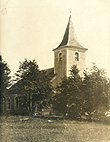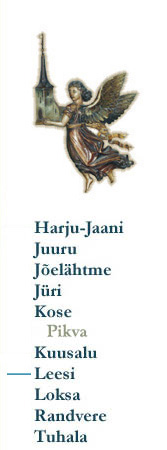
<< Back
|
 LEESI
Leesi church, consecrated to St. Catherine, was built between
the years 1865-67 as a successor to the Juminda chapel. A new
chapel building erected in Loksa a little earlier (1853) served
as a model for the new church. Both Leesi and Loksa served
as the seaside auxiliary churches for the Kuusalu Congregation.
This is why the local speak still often calls them chapels,
though the congregations have been independent for several
decades now.
The story of how the old Juminda chapel and the new church
were built is told in the song sheet printed for the 50th birthday
of Leesi church. According to the tale, the first chapel stood on
the tip of Cape Juminda and ships rarely passed without the sailors
coming to the hill, thanking God in the chapel and placing
their gifts in the collection box. It is not known when the chapel
was built, but it was already so old by 1678 that a new chapel
had to be built. That same year it was erected in the village of
Juminda, but in a different place. The cost for the next chapel
was born by Gustaw Otto Stenbock who was then the Count of
Kolga. However, by 1865 this chapel was also too old as its walls
and towers had long leaned out of right angles and people were
afraid to enter during stormy weather.
The congregation had to contemplate building a new chapel. The
initial meetings could not decide where to erect the building.
Eastern villages on the peninsula rooted for Juminda, western
villages supported Leesi. In the end, the majority leaned towards
the village of Leesi and the cornerstone for the current chapel was
laid on May 15, 1865. Construction lasted for almost 18 months.
The old Juminda chapel hosted its last Holy Communion on
September 17, 1867 and on October 1, Eastern Harjumaa dean
Berg consecrated the new Leesi chapel in the presence of several
other reverends as the House of the Lord.
Dean Woldemar Friedrich Kentmann has written in the church
chronicles that the Leesi chapel was built according to the plans
of the new Loksa chapel, but with smaller dimensions. The chapel
erection was said to have cost 750 roubles in cash, including
150 roubles for organ construction. Much of this was collected
through voluntary donations and 200 roubles were given by the
help fund of the Evangelic Lutheran congregations. Count Stenbock
provided the materials, bought a used organ for 100 roubles
and paid the salary of one mason for the first year of construction.
On the day of consecration, the congregation still had a debt of
about 100 roubles.
The slightly rising road that takes to the Leesi church stairs, hidden
behind the ancient linden trees, traverses through a long stretch
of the Leesi cemetary – the church is built in the northeastern
corner of the village graveyard. After entering the limestone building
through the lobby under the tower, the visitor arrives in a
single rectangular room that has a horizontal wooden ceiling and
is illuminated by relatively wide, slightly upward curving window
holes. There is no separate choir and no sacristy. The organ, built
in 1905 by Gustav Terkmann (Targamaa), the organ master with
Estonian roots, is not located on the western balcony, but in front
of the men’s pew section, its flank towards the audience. The
organ has one manual, one pedal and 8 organ stops.
Next to the northern wall, on the same line as the organ, is the
colorful pulpit that has space for the carved figures of Jesus Christ
and three Evangelists in its side niches. This Early Baroque pulpit
had been in the old Harju-Jaani church that was demolished
in 1864 and traveled to the Leesi chapel as a benevolent donation
by a neighboring congregation – albeit having undergone
reconstruction and missing its abat-voix and artfully finished
base. The figure of the fourth Evangelist (Matthew) is still in
Harju-Jaani. Maybe this joinery and carving work, finished in
1646, was made in the workshop of Tobias Heintze, the most
renowned Tallinn master of that time?
The first altarpiece in the new church was “Christ on the Cross”,
an oil painting on wooden panel from the end of the 17th century
or the beginning of the 18th century, that probably belonged to
the former Juminda chapel. When the pseudo-Gothic altar wall
was installed in 1884 the old altarpiece was replaced by a twopiece
canvas “Save me, Lord!” (upper section depicting Christ on
the cross), painted by Theodor Albert Sprengel (1832-1900), a
painter and drawing teacher from Tallinn. This storyline from the
Gospel of Matthew 14, 28-31, where drowning Peter clings to the
hand of his Savior in the life-threatening fury of the sea waves,
was a particular favorite in coastal chapels. The canvas “Christ on
a Cross”, approximately as old as the former altarpiece, bears the
author’s signature Tõno Mick and is also from Juminda chapel.
The oldest art objects in Leesi church are indeed from the Juminda
chapel and these include the wooden and wrought iron
wad of cash for gathering donations, a wondrous collection of
very old candelabra, several lead chalices and patens. Especially
unique is a three-branched candelabrum that is therefore not
kept in a church, but in a safer place. The three-mast model of
a sailing ship that is hanging in the lobby under the tower was
made by the local peasant Mart Paadimeister in the 1920s.
LEESI
Leesi church, consecrated to St. Catherine, was built between
the years 1865-67 as a successor to the Juminda chapel. A new
chapel building erected in Loksa a little earlier (1853) served
as a model for the new church. Both Leesi and Loksa served
as the seaside auxiliary churches for the Kuusalu Congregation.
This is why the local speak still often calls them chapels,
though the congregations have been independent for several
decades now.
The story of how the old Juminda chapel and the new church
were built is told in the song sheet printed for the 50th birthday
of Leesi church. According to the tale, the first chapel stood on
the tip of Cape Juminda and ships rarely passed without the sailors
coming to the hill, thanking God in the chapel and placing
their gifts in the collection box. It is not known when the chapel
was built, but it was already so old by 1678 that a new chapel
had to be built. That same year it was erected in the village of
Juminda, but in a different place. The cost for the next chapel
was born by Gustaw Otto Stenbock who was then the Count of
Kolga. However, by 1865 this chapel was also too old as its walls
and towers had long leaned out of right angles and people were
afraid to enter during stormy weather.
The congregation had to contemplate building a new chapel. The
initial meetings could not decide where to erect the building.
Eastern villages on the peninsula rooted for Juminda, western
villages supported Leesi. In the end, the majority leaned towards
the village of Leesi and the cornerstone for the current chapel was
laid on May 15, 1865. Construction lasted for almost 18 months.
The old Juminda chapel hosted its last Holy Communion on
September 17, 1867 and on October 1, Eastern Harjumaa dean
Berg consecrated the new Leesi chapel in the presence of several
other reverends as the House of the Lord.
Dean Woldemar Friedrich Kentmann has written in the church
chronicles that the Leesi chapel was built according to the plans
of the new Loksa chapel, but with smaller dimensions. The chapel
erection was said to have cost 750 roubles in cash, including
150 roubles for organ construction. Much of this was collected
through voluntary donations and 200 roubles were given by the
help fund of the Evangelic Lutheran congregations. Count Stenbock
provided the materials, bought a used organ for 100 roubles
and paid the salary of one mason for the first year of construction.
On the day of consecration, the congregation still had a debt of
about 100 roubles.
The slightly rising road that takes to the Leesi church stairs, hidden
behind the ancient linden trees, traverses through a long stretch
of the Leesi cemetary – the church is built in the northeastern
corner of the village graveyard. After entering the limestone building
through the lobby under the tower, the visitor arrives in a
single rectangular room that has a horizontal wooden ceiling and
is illuminated by relatively wide, slightly upward curving window
holes. There is no separate choir and no sacristy. The organ, built
in 1905 by Gustav Terkmann (Targamaa), the organ master with
Estonian roots, is not located on the western balcony, but in front
of the men’s pew section, its flank towards the audience. The
organ has one manual, one pedal and 8 organ stops.
Next to the northern wall, on the same line as the organ, is the
colorful pulpit that has space for the carved figures of Jesus Christ
and three Evangelists in its side niches. This Early Baroque pulpit
had been in the old Harju-Jaani church that was demolished
in 1864 and traveled to the Leesi chapel as a benevolent donation
by a neighboring congregation – albeit having undergone
reconstruction and missing its abat-voix and artfully finished
base. The figure of the fourth Evangelist (Matthew) is still in
Harju-Jaani. Maybe this joinery and carving work, finished in
1646, was made in the workshop of Tobias Heintze, the most
renowned Tallinn master of that time?
The first altarpiece in the new church was “Christ on the Cross”,
an oil painting on wooden panel from the end of the 17th century
or the beginning of the 18th century, that probably belonged to
the former Juminda chapel. When the pseudo-Gothic altar wall
was installed in 1884 the old altarpiece was replaced by a twopiece
canvas “Save me, Lord!” (upper section depicting Christ on
the cross), painted by Theodor Albert Sprengel (1832-1900), a
painter and drawing teacher from Tallinn. This storyline from the
Gospel of Matthew 14, 28-31, where drowning Peter clings to the
hand of his Savior in the life-threatening fury of the sea waves,
was a particular favorite in coastal chapels. The canvas “Christ on
a Cross”, approximately as old as the former altarpiece, bears the
author’s signature Tõno Mick and is also from Juminda chapel.
The oldest art objects in Leesi church are indeed from the Juminda
chapel and these include the wooden and wrought iron
wad of cash for gathering donations, a wondrous collection of
very old candelabra, several lead chalices and patens. Especially
unique is a three-branched candelabrum that is therefore not
kept in a church, but in a safer place. The three-mast model of
a sailing ship that is hanging in the lobby under the tower was
made by the local peasant Mart Paadimeister in the 1920s.

|
 |

|





